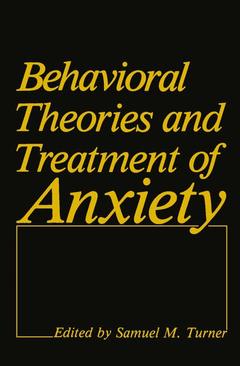Description
Behavioral Theories and Treatment of Anxiety, Softcover reprint of the original 1st ed. 1984
Language: English
Keywords
Syndrom; Therapie; anxiety; anxiety disorder; assessment; brain; depression; epidemiology; etiology; intervention; management; prevention; schizophrenia; syndromes; therapy
Publication date: 03-2012
438 p. · 15.2x22.9 cm · Paperback
438 p. · 15.2x22.9 cm · Paperback
Description
/li>Contents
/li>
When behavior therapy was first applied to what would now be labeled an anxiety disorder, a simplistic theoretical model guided the treatment of a sim ple phobia. Time and research have shown that the techniques of behavior ther apy have been more successful than its models have been explanatory. Yet progress has been substantial in both realms, as the following volume makes patently clear. In 1980 an inventory of this progress was catalogued at an NIMH-sponsored workshop. What both that workshop and this volume clearly show is that the behav ior therapy researcher need no longer suffer the epithet "overly simplistic." One of the major strengths of this volume is its elucidation of the complexities that now attend the study of the anxiety disorders, particularly from a behav ioral point of view. The researcher at times appears almost to be buried in a landslide of complexities regarding this topic. The concept of anxiety itself has undergone a differentiation to a level of complexity that poses problems for both the conceptualization and the treat ment of anxiety disorders. In virtually one voice, the several authors of this volume argue the multidimensional nature of anxiety. The "lump" view of anx iety has given way to the three-channel view of anxiety. An investigator's future research career could well be secured just by spending time puzzling out the significance of the low intercorrelations among the channels.
1 Behavioral Theories of Anxiety Disorders.- The Scope of Anxiety Disorders.- Behavioral Theories of Anxiety Events.- Theories Involving Anxiety Constructs.- Future Directions.- Summary.- References.- 2 Measurement of Anxiety.- Conceptualizations of Anxiety.- Anxiety Measurement Methods.- Anxiety Assessment in Children.- Preliminary Screening and Assessment Procedures.- A Case Study.- Summary and Conclusions.- References.- 3 Simple Phobia.- Defining Characteristics.- Theories.- Assessment of Simple Phobias.- Various Treatment Approaches.- Systematic Desensitization.- Implosive Therapy.- Flooding.- Reinforced Practice.- Modeling Procedures.- Cognitive Therapies.- Choosing the Appropriate Treatment Procedures and Parameters.- Summary and Conclusions.- References.- 4 Agoraphobia.- Definition and Description.- Assessment of Agoraphobia.- Treatment of Agoraphobia.- Conclusions.- References.- 5 Panic Disorder: Medical and Psychological Parameters.- Panic Disorder as a Psychiatric Condition.- Differential Diagnostic Problems.- Related Conditions—The Hyperventilation Syndrome.- Medical Conditions Presenting with Panic.- Behavioral Treatment of Panic.- Conclusions.- References.- 6 Obsessive-Compulsive Disorders.- Epidemiology.- Relationship to Other Disorders.- Cognitive Factors in Obsessive-Compulsive Disorder.- Obsessive-Compulsive Disorder and Anxiety.- Assessment of Obsessions and Compulsions.- Treatment.- Summary.- References.- 7 Generalized Anxiety Disorder.- Symptom Expression.- Symptom Severity.- Types of Anxiety Management Programs.- Model of Generalized Anxiety.- References.- 8 Social Phobia.- The Nature and Prevalence of Social Phobia.- Explanation of Social Phobia: Its Cause and Maintenance.- Therapy.- Summary.- References.- 9 School Phobia.- Diagnostic Issues.-Incidence.- Etiological Considerations.- Assessment Issues.- Treatment Issues.- Prevention.- Summary and Conclusions.- References.- 10 Anxiety Disorders in Childhood.- Definitions.- Etiology.- Assessment.- Treatment of Anxiety Disorders in Children.- Treatment Outcome.- Clinical Recommendations.- References.
© 2024 LAVOISIER S.A.S.
These books may interest you

Insomnia and Anxiety 179.34 €



